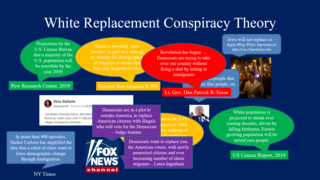Memory
The Stain on the Wall: How False Ideas Stick With Us
Even when the details are forgotten.
Posted June 15, 2022 Reviewed by Lybi Ma
Key points
- People generally forget individual statements but will remember the gist of the idea.
- Disinformation campaigns present varied ideas that are often discredited, but people remember the gist of the implied idea.
- To counteract disinformation campaigns, the truth must be as aggressive, people must spread and repeat true information.
Out, damned spot. Lady Macbeth’s famous line concerns seeing the blood of a murdered man on her hands. She washed her hands and tried to remove the stain. But the stain remains in her mind. In her dreams and while sleepwalking, she rubs her hands trying to remove the spot of blood from the man her husband and she murdered.
Stains are hard to remove. Even when the evidence is gone, we may still see and remember the remnants. Similarly, the gist of ideas sticks with us, even when the details are lost or discredited.
The Spaghetti on the Wall
In a recent Twitter thread, Kate Starbird noted something similar about the effects of disinformation campaigns. During a disinformation campaign, people will toss out a lot of ideas. Imagine those ideas as pieces of spaghetti thrown against the wall. Some ideas stick. Many bounce off and fall to the ground. Eventually, the spaghetti dries out and the crusty pieces fall as well. In this fashion, the details of the disinformation campaign are lost as the news moves to another topic. But Starbird suggested a critical addition to the metaphor. Add some spaghetti sauce. If the noodles are coated in a nice tomato sauce, that will splatter against the wall as well, and a tomato sauce stain is hard to remove. The stain will remain on the wall and the idea will remain in someone’s mind. The basic idea of the disinformation campaign will remain.
The Gist of an Idea
In cognitive psychology, we study how people remember the details of an experience and the gist of an idea. In a classic study, Bransford and Franks (1971) threw spaghetti against the wall and measured the resulting stain. Actually, what they did was give people short sentences and then asked them questions about each one (here are four examples of a longer set).
The girl lives next door. Who does?
The scared cat was running from the dog. What was?
The girl who lives next door broke the window. Broke what?
The dog was barking. What was?
In creating the sentences that people studied, Bransford and Franks related each to an underlying understanding of different situations—the basic gist. Some sentences presented pieces of the underlying idea that ‘the girl who lives next door broke the large window on the porch.’ Others were related to the idea that ‘the scared cat running from the barking dog jumped on the table.’ Crucially, the full idea was never presented. Yet when people were given a memory test later, they often rejected some of the small pieces they did see and consistently accepted the basic underlying idea—the gist remained.
The Gist of Disinformation, the Stain on the Wall
In a recent presentation about disinformation, I talked about that study and memory for the gist. But I also considered how it would apply in a disinformation campaign. How could the spaghetti tossed against the wall leave a stain? Let’s consider White Replacement Conspiracy Theory. This is a disinformation campaign that suggests that some unidentified group of elites is conspiring to change the voters in the US. The idea is that these elites are bringing in immigrants to replace the existing population so they can hold power. This set of ideas contains racism and anti-immigrant undertones. Many politicians and media personalities have made statements related to this idea (see the image for some examples). You can find reports about these statements in articles from The New York Times, the Washington Post, and NPR. The Times noted that this basic idea has been covered in some form on over 400 of Tucker Carlson’s shows on Fox News in the last few years. That’s a lot of spaghetti being thrown against the wall.

But people generally will forget these individual statements. Even if they do remember the statements, they probably won’t recall where they heard them.
The gist remains. The stain on the wall is hard to remove. In the case of this conspiracy theory, the basic idea is widely accepted. In a recent survey, the Associated Press asked if people agreed with the idea that a group of elites was trying to replace native-born Americans with immigrants who agreed with their political views. Around one-third of respondents stated they agreed with the statement: 32 percent agreed with the underlying idea of a conspiracy theory. The disinformation campaign has left a serious stain.
A Hopeful Approach
To counter disinformation, the truth must be as aggressive. In a recent study, Broockman and Kalla (2022) paid people to switch from watching Fox News to CNN for a month. When people changed their news diet, their knowledge and beliefs changed as well. Providing accurate information early may make it harder for disinformation to leave a stain. And changing to accurate information even after exposure to disinformation may help to clean the stain off the wall, to change the gist that remains. But it takes time and a lot of truthful information. And when people went back to watching Fox, their ideas and beliefs returned to baseline.
The Risk of Disinformation
The risk of disinformation campaigns is not simply the individual statements. Those ideas are the spaghetti thrown against the wall. The risk is that the underlying idea will remain. And then we may wander the halls at night like Lady Macbeth trying constantly to remove the stains from our hands, from our minds, from the minds of our neighbors. The damage of disinformation campaigns will outlast individual false statements.
References
Bransford, J. D., & Franks, J. J. (1971). The abstraction of linguistic ideas. Cognitive Psychology, 2(4), 331-350.
Broockman, D., & Kalla, J. (2022). The manifold effects of partisan media on viewers’ beliefs and attitudes: A field experiment with Fox News viewers. OSF Preprints.


